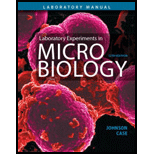
Concept explainers
Why do gram-positive cells more than 24 hours old stain gram-negative?
To write:
The reason for iodide can be added before the primary stain in a gram strain.
Introduction:
Staining is a method that provides variance to the microscopic image for enhanced vision under the microscope. It is a method that is extensively used for the assessment of cells and tissue components. It is often used to draw attention to the microbial structures for viewing with the help of diverse microscopes.
Explanation of Solution
Gram staining:
It is a common method that is used to distinguish two large bacterial groups based on their dissimilar cell wall components. The Gram stain process differentiates between the Gram-positive and negative bacterial groups by coloring these cells violet or red.
Gram-negative bacteria:
It loses the crystal violet stain in the Gram staining method. It is a feature of bacteria which contain a cell wall made up of thin layer peptidoglycan.
Gram-positive bacteria:
These bacteria contain a very thick cell wall of peptidoglycan. These gram-positive bacteria hold the crystal violet dye.
The reason for the gram-positive cells that are more than 24 hours old can stain gram-negative:
Because in the older cells, the cell walls become degenerate and lose the purple dye.
In the older cells, the cell walls become degenerate and lose the purple dye.
Want to see more full solutions like this?
Chapter 7 Solutions
Laboratory Experiments in Microbiology (12th Edition) (What's New in Microbiology)
- Unit Conversions: If the field of view at 10x is 3.1x106 µm2, what would it be in mm2. Report your answer with 2 significant digits. 1 mm = 1000 µm. Include units in your answer.arrow_forwardHi, Please type the whole transcript correctly using comma and periods and as needed. The picture of a video on YouTube has been uploaded down.arrow_forwardHSCI701_D04_202520 Quizzes Quiz: References, Quotations, and Formatting Quiz: References, Quotations, and Formattingarrow_forward
- If you transplant trunk neural crest into the cranial neural crest region of a developing embryo, will you see the donor tissue form cartilage? Does the neural crest only give rise to two cells in the developing embryo, and is essential for lamprey to develop their jaw structure? Does a multipotent neural crest cell that is receiving Wnt signals become a Chromaffin cell?arrow_forwardUsing quail and chick embryos, quail-specific antibody and fluorescent tissue-specific antibodies, design an experiment where you investigate the tissues the cranial neural crest can give rise to. What are four derivatives of the cranial neural crest that you expect to see in the resulting chimeric embryos?arrow_forwardDoes the neural crest have to undergo epithelial to mesenchymal transition prior to migration through the developing embryo? Does the neural crest differentiate into different cell types based on their axial position along the anterior and posterior axis?arrow_forward
- Using quail and chicken embryos, what kind of experiment would you conduct to test if rib forming somites have their axial identity specified before segmentation? How do we know this phenotype is due to axial identity being specified before segmentation and not due to our experimental method?arrow_forward8. Aerobic respiration of a 5 mM solution of tripeptide that is composed of the following three amino acids; alanine, leucine and isoleucine. Alanine breaks down to pyruvate, leucine breaks down to Acetyl-CoA and isoleucine breaks down to succinyl-CoA. Alanine NADH FADH2 OP ATP SLP ATP Total ATP Leucine Isoleucine Totals Show your work using dimensional analysis here: 4arrow_forward9. Aerobic respiration of one lipid molecule. The lipid is composed of one glycerol molecule connected to two fatty acid tails. One fatty acid is 12 carbons long and the other fatty acid is 18 carbons long in the figure below. Use the information below to determine how much ATP will be produced from the glycerol part of the lipid. Then, in part B, determine how much ATP is produced from the 2 fatty acids of the lipid. Finally put the NADH and ATP yields together from the glycerol and fatty acids (part A and B) to determine your total number of ATP produced per lipid. Assume no other carbon source is available. fatty acids glycerol 18 carbons 12 carbons 0=arrow_forward
- Surgical Tech For Surgical Tech Pos CareHealth & NutritionISBN:9781337648868Author:AssociationPublisher:Cengage
 Principles Of Radiographic Imaging: An Art And A ...Health & NutritionISBN:9781337711067Author:Richard R. Carlton, Arlene M. Adler, Vesna BalacPublisher:Cengage Learning
Principles Of Radiographic Imaging: An Art And A ...Health & NutritionISBN:9781337711067Author:Richard R. Carlton, Arlene M. Adler, Vesna BalacPublisher:Cengage Learning  Concepts of BiologyBiologyISBN:9781938168116Author:Samantha Fowler, Rebecca Roush, James WisePublisher:OpenStax College
Concepts of BiologyBiologyISBN:9781938168116Author:Samantha Fowler, Rebecca Roush, James WisePublisher:OpenStax College Biology 2eBiologyISBN:9781947172517Author:Matthew Douglas, Jung Choi, Mary Ann ClarkPublisher:OpenStax
Biology 2eBiologyISBN:9781947172517Author:Matthew Douglas, Jung Choi, Mary Ann ClarkPublisher:OpenStax





